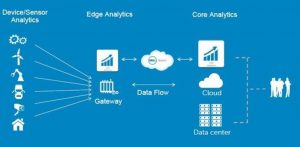The pros and cons of IoT edge analytics
A whopping 55 billion IoT devices are predicted to be in businesses and households across the world by 2025, and this vast array of technology brings with it an enormous amount of data. Developers, business analysts and consumers alike benefit from the collection and understanding of this data, used to derive insights and improve products. However, the enormous growth in the amount of data is causing a bottleneck: not everything can be analyzed, and the transmission of all this information to the cloud for analysis is slow and inefficient. Edge analytics aims to streamline the data analysis process in order to utilize as much of the relevant information as possible, more efficiently than traditional methods.
What is edge analytics?
Edge analytics are tools that sit on or close to IoT devices to collect, process and analyze data at the source rather than sending that data back to the cloud for analysis. This streamlines the data analysis process by performing it in real time and in situ to ensure as much useful information is garnered from the device as possible. Devices are designed to contain their own analytical capabilities to this end. For example, a light sensor at a traffic light can be built with intelligent monitoring for traffic management. Real-time feedback within the device itself ensures immediate and appropriate use of the data it is gathering, circumventing the need to send the data elsewhere for outside consideration.
Pros of edge analytics
More and more companies are becoming proponents of edge analytics, and here’s why.
Saves time
Centralized systems, where all data collected by internet-connected devices are sent in their raw state for processing, are inherently slow. All of the raw data, whether relevant or not, must be cleaned, processed and analyzed to extract any value it contains. Ninety-percent of deployed data is useless, and 32% is inaccurate; but in a centralized system, all data is given equal status until an analysis is complete. An edge analytics system aims to filter out the unnecessary information before analysis, and only relevant data is run through higher order systems. This saves both processing and uploading time and makes the complex analytical stage, performed on the cloud, much more efficient.
In critical environments, such as in industrial settings, real-time analysis is not only more efficient, but it also significantly reduces the latency of essential decisions too. If a valve is faulty, it can be shut off by the local system quickly, rather than relying on connectivity to a central analytics environment and waiting for results before taking emergency action.
Lowers costs
Edge analytics reduces the cost of data storage and management. It also lowers operational costs, minimizes needed bandwidth and reduces resources spent on data analysis. These factors all combine to provide significant financial savings. It should also be noted that currently a majority of industrial IoT data is never even analyzed, which equates to wasted information and lost improvements. When the volume of data starts inhibiting analysis, edge analytics provides a cost-effective route to extracting as much use from the data as possible, for the benefit of the business.
Preserves privacy
When sensitive or confidential information is captured by a device (such as GPS data or video streams), this sensitive information is preprocessed on site and not simply bulk uploaded to the cloud for processing. This extra step means that only privacy-compliant data “leaves” the device for further analysis, and it goes through an anonymizing aggregation in preprocessing. Sensitive content is preserved without losing out on the benefits complex cloud-based analysis can offer.
Connectivity issues
Despite the prevalence of internet connected devices, connectivity issues are still an ongoing problem. Edge analytics protects against potential connectivity outages by ensuring that applications are not disrupted by limited or intermittent network connectivity. This is especially useful in remote locations, or when attempting to reduce connectivity costs when using expensive technologies like cellular.
Cons of edge analytics
Lost data
Edge analytics isn’t all up-side; the efficiency it brings comes at a cost. Only a subset of data will be processed and analyzed, with results being sent over the network. This effectively means that raw data is being discarded and this inevitably results in missing some insights it could have offered. The type of device and use of the data needs to be considered — is the loss of data critical, or a necessary aspect of increased efficiency?
A retail company may decide that optimizing data efficiency is more important than losing theoretical data insights, but an airline cannot make the same judgment call. When safety is a concern, the collection of all raw data and analysis off site is still the better approach, despite being more inconvenient.
The future of edge analytics
IoT edge analytics is currently extremely applicable to large-scale industries which operate in low-bandwidth, low-latency environments, such as oil rigs, factories and mines. But while the technology grew legs here, it is set to expand in keeping with IoT growth around the world, across all industries. Leading the way are the travel and logistics industries, but sensors and other forms of data collection are becoming more and more ubiquitous across all walks of life; for example, a single Airbus A350 generates 2.5 Tb of data per day.
Cisco estimates that 507.5 zettabytes of data will be generated in 2019 alone. Interim processing is increasingly relevant for handling this staggering volume of data, and edge analytics offer a cost-effective, relatively efficient solution. Forty percent of IoT data in 2018 is expected to be processed through edge analytics, and this number will surely grow with IoT.
All IoT Agenda network contributors are responsible for the content and accuracy of their posts. Opinions are of the writers and do not necessarily convey the thoughts of IoT Agenda.

